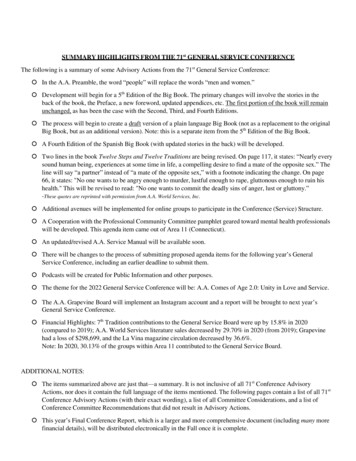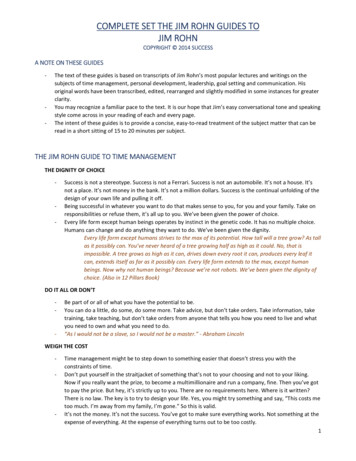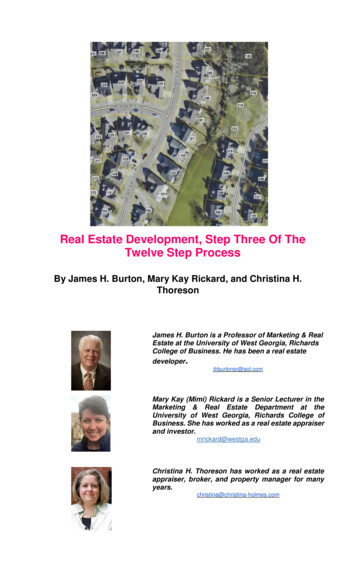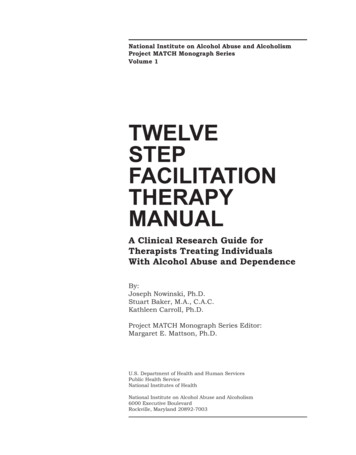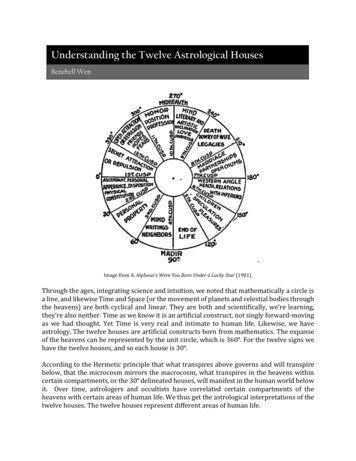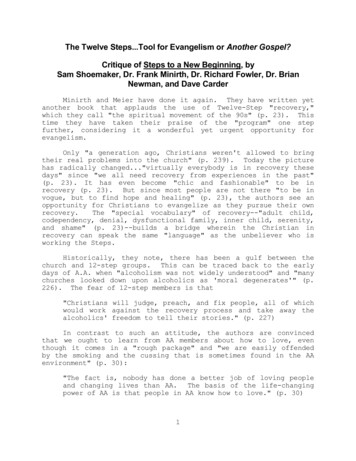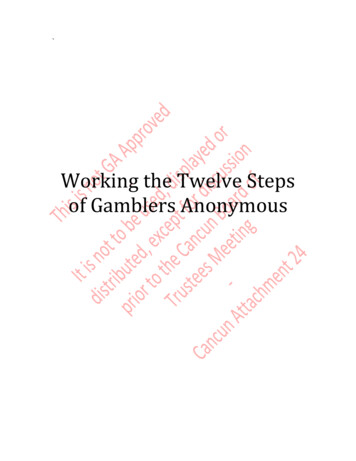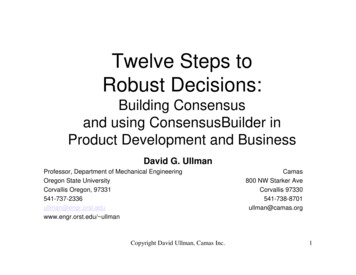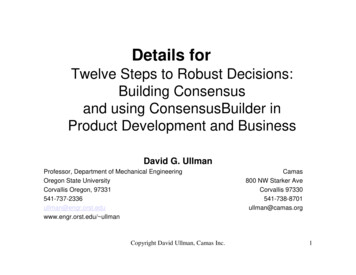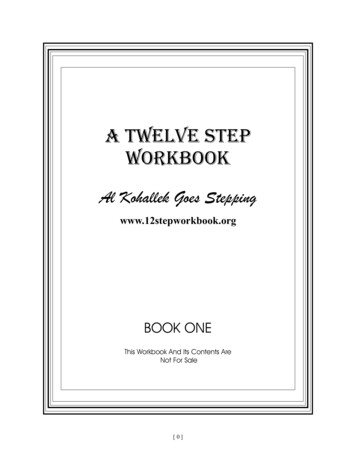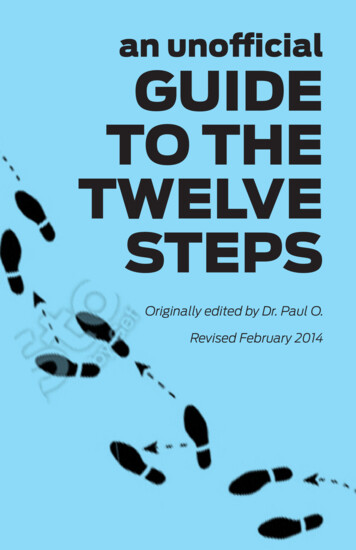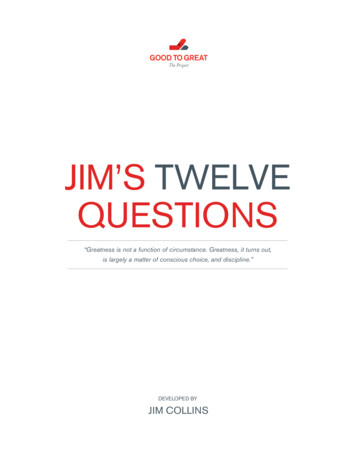
Transcription
GOOD TO GREATThe ProjectJIM’S TWELVEQUESTIONS“Greatness is not a function of circumstance. Greatness, it turns out,is largely a matter of conscious choice, and discipline.”DEVELOPED BYJIM COLLINS
pg 1Jim’s Twelve QuestionsBackground on the Twelve Questions—A Note from JimIn 1988, I had the great privilege to inherit teaching responsibility for a course on entrepreneurship and smallbusiness management at the Stanford Graduate School of Business. As I was preparing for my first year of teaching,I began to revise the syllabus for the course. The opening line of the syllabus read something like, “this will be acourse on the mechanics and challenges of the entrepreneur and small business manager.” For some reason, Iimpulsively changed the opening line to reframe the course around the question of what it would take to turn anentrepreneurial venture or small business into an enduring great company. I remember looking at that new openingsentence, and thinking to myself, “Wow, I don’t know anything about that.”And thus began what would become a passionate quest—a quarter century of research, writing, and thinking aboutthe question of what it takes to build an enduring great company or social sector enterprise. The result is more than6,000 years of combined corporate history in a research database, six books, a range of articles, and a monographtranslating some of the key ideas into the challenges faced by social sector leaders. These works included Built toLast (co-authored with Jerry Porras), Great by Choice (co-authored with Morten Hansen), Beyond Entrepreneurship(co-authored with Bill Lazier), How the Mighty Fall, and the cornerstone work Good to Great, along with its companion monograph Good to Great and the Social Sectors.In 2012, I began to get a lot of questions from people who wanted to engage with the body of work, not just onebook, so that they would have the best chance to build a great enterprise. The questions were along the lines of:“Where as a leadership team should we begin?” “Is there a best sequence to the reading, or to engaging with theconcepts?” “What is the best way to challenge a team to engage with the full body of work?”After reflecting on these questions, I decided to construct a sequence of Twelve Questions that would serve as amechanism of disciplined thought for a leader and his or her team. The questions are designed to help you efficientlyaccess the full body of work, in what I believe is a highly-effective sequence, along with readings corresponding toeach question. I encourage you and your team to discuss one question per month, to fill out an entire year ofdisciplined thought. The most powerful results will come from repeating the cycle, rigorously hitting each question atleast once per year. At the end of a year, you can further self-assess using the Good to Great Diagnostic Tool,available at www.jimcollins.com.Jim CollinsThe Good to Great Project LLCBoulder, COJIM’S TWELVE QUESTIONS DEVELOPED BY JIM COLLINS. RELEASE VERSION 3.00. 2014 BY JIM COLLINS. ALL RIGHTS RESERVED.
pg 2Jim’s Twelve QuestionsWhat Defines “Great”Before jumping into the Twelve Questions, let me first address the question: what is a great enterprise, be it a greatcompany or a great social sector enterprise? Not how you build one, but what is a great organization—what are thecriteria of greatness? There are three tests: Superior Results, Distinctive Impact, and Lasting Endurance.Superior ResultsIn business, performance is defined by financial results—return on invested capital—and achievement of corporatepurpose. In the social sectors, performance is defined by results and efficiency in delivering on the social mission.But whether business or social, you must achieve top-flight results. To use an analogy, if you are a sports team, youmust win championships; if you don’t find a way to win at your chosen game, you cannot be considered truly great.Distinctive ImpactA truly great enterprise makes such a unique contribution to the communities it touches, and does its work with suchunadulterated excellence that, if it were to disappear, it would leave a gaping hole that could not be easily filled by anyother institution on the planet. If your organization went away, who would miss it, and why? This does not requirebeing big; think of a small but fabulous local restaurant that would be terribly missed if it disappeared. Big does notequal great, and great does not equal big.Lasting EnduranceA truly great organization prospers over a long period of time, beyond any great idea, market opportunity, technologycycle, or well-funded program. When clobbered by setbacks, it finds a way to bounce back stronger than before. Agreat enterprise transcends dependence on any single extraordinary leader; if your organization cannot be greatwithout you, then it is not yet a truly great organization.Finally, I caution against ever believing that your organization has achieved an end-state of greatness. To be built tolast means embracing the idea that good to great is never done. No matter how far we have gone, or how much wehave achieved, we are merely good relative to what we can do next. Greatness is an inherently dynamic process, notan end point. The moment you think of yourself as great, your slide toward mediocrity will have already begun.JIM’S TWELVE QUESTIONS DEVELOPED BY JIM COLLINS. RELEASE VERSION 3.00. 2014 BY JIM COLLINS. ALL RIGHTS RESERVED.
pg 3Jim’s Twelve QuestionsJim’s Twelve Questions1.Are we willing to strive for Level 5 Leadership, and to embrace the 10X behaviors needed to build agreat company or social sector enterprise? Reading: Good to Great, Chapters 1, 2; Great by Choice, Chapters 1, 2; article at jimcollins.com: “Built to Flip” For leaders in the social sectors, first read: Good to Great and the Social Sectorsnotes:2.Do we practice the principle of First Who, with the Right People on the Bus and in the right seats? Reading: Good to Great, Chapter 3; How the Mighty Fall, Appendix 5notes:3.What are the Brutal Facts, and how can we better live the Stockdale Paradox? Reading: Good to Great, Chapter 4notes:4.What do we understand so far about our Hedgehog Concept—what we are fanatically passionate about,what we can (and cannot) be the best at, and what drives our economic or resource engine? Reading: Good to Great, Chapters 5, 6notes:5.How can we accelerate clicks on the Flywheel by committing to a 20 Mile March? Reading: Good to Great, Chapters 7, 8; Great by Choice, Chapter 3notes:6.Where should we place our big bets, based on the principle “Fire Bullets, then Cannonballs”—blendingcreativity and discipline to scale innovation? Reading: Great by Choice, Chapter 4notes:JIM’S TWELVE QUESTIONS DEVELOPED BY JIM COLLINS. RELEASE VERSION 3.00. 2014 BY JIM COLLINS. ALL RIGHTS RESERVED.
pg 4Jim’s Twelve Questions7.Do we show any signs of How the Mighty Fall, and do we have enough Productive Paranoia to stayfar above the Death Line? Reading: How the Mighty Fall; Great by Choice, Chapter 5notes:8.How can we do a better job at Clock Building, not just Time Telling? Reading: Built to Last, Chapters 1, 2; article at jimcollins.com: “Aligning Action and Values”notes:9.Do we passionately embrace the Genius of the AND—especially the fundamental dynamic of “Preservethe Core AND Stimulate Progress”? Reading: Built to Last, Interlude “No ‘Tyranny of the OR’ (Embrace the ‘Genius of the AND’)”, Chapters 3, 4notes:10.What is our BHAG – our Big Hairy Audacious Goal – and do we have the SMaC to achieve it?Reading: Built to Last, Chapter 5; Good to Great, Chapter 9; Great by Choice, Chapter 6For those in small business, also consider: Beyond Entrepreneurship, Chapters 2, 3, 5 Useful tool at jimcollins.com: Vision Framework notes:11.How can we increase our Return on Luck (ROL), making the most of our good luck and bad? Reading: Great by Choice, Chapter 7, Epilogue, FAQnotes:12.What should be on our Stop Doing list? Reading: article at jimcollins.com: “Best New Year’s Resolution? A ‘Stop Doing’ List” Useful tool at jimcollins.com: Good to Great Diagnostic Toolnotes:JIM’S TWELVE QUESTIONS DEVELOPED BY JIM COLLINS. RELEASE VERSION 3.00. 2014 BY JIM COLLINS. ALL RIGHTS RESERVED.
pg 5Jim’s Twelve QuestionsTerms of UseConsent to TermsYour use of Jim’s Twelve Questions is subject to these Terms of Use (“Terms”). Please read them carefully. The term “you” means theindividual person who is using Jim’s Twelve Questions; “we” or “us” or “our” refers to THE GOOD TO GREAT PROJECT LLC, which hasbeen given the right by Jim Collins, holder of the copyright to Jim’s Twelve Questions, to distribute Jim’s Twelve Questions to you. By usingJim’s Twelve Questions, you agree to be bound by these Terms. If you do not agree with, or cannot abide by these Terms, please do not makeany use of Jim’s Twelve Questions.CopyrightsThe content of Jim’s Twelve Questions is protected by U.S. and international copyright laws. You may use, reproduce, distribute, transmit, ordisplay Jim’s Twelve Questions only within the limits imposed by these Terms. You may not modify or make any derivative works of Jim’sTwelve Questions. You may use, copy, or distribute Jim’s Twelve Questions only for your personal (including intra-company) use andyou must include all copyright and other notices contained in Jim’s Twelve Questions. If you desire to obtain copies of Jim’s Twelve Questionsfor use in situations other than under the permission granted above, please contact us at The Good to Great Project LLC, PO Box 1699,Boulder, CO 80306.DISCLAIMERJIM’S TWELVE QUESTIONS IS PROVIDED ON AN “AS IS” AND “AS AVAILABLE” BASIS, WITHOUT ANY WARRANTIES OF ANY KIND,EITHER EXPRESS OR IMPLIED, INCLUDING WARRANTIES OF TITLE OR IMPLIED WARRANTIES OF MERCHANTABILITY OR FITNESSFOR A PARTICULAR PURPOSE. NO WARRANTIES ARE MADE REGARDING ANY RESULTS THAT MAY BE OBTAINED FROM USE OFJIM’S TWELVE QUESTIONS.LIMITATION OF LIABILITYIN NO EVENT WILL JIM COLLINS, THE GOOD TO GREAT PROJECT LLC, THEIR MANAGERS, EMPLOYEES OR AGENTS BE LIABLEFOR ANY DIRECT, INDIRECT, CONSEQUENTIAL, SPECIAL, INCIDENTAL OR PUNITIVE DAMAGES, ARISING OUT OF THE USE ORINABILITY TO USE JIM’S TWELVE QUESTIONS OR ANY RESULTS OBTAINED FROM USE OF JIM’S TWELVE QUESTIONS. IN THEEVENT THE FOREGOING LIMIT IS NOT EFFECTIVE TO LIMIT ALL LIABILITY FOR MONEY DAMAGES, IN NO EVENT WILL JIM COLLINS,THE GOOD TO GREAT PROJECT LLC, THEIR MANAGERS, EMPLOYEES OR AGENTS BE LIABLE FOR ANY AMOUNT IN EXCESS OF 100 ARISING OUT OF OR RELATING TO JIM’S TWELVE QUESTIONS OR ITS USE. THIS LIMITATION OF LIABILITY IS CUMULATIVE,WITH ALL PAYMENTS FOR CLAIMS OR DAMAGES RELATING TO JIM’S TWELVE QUESTIONS OR ITS USE BEING AGGREGATED TODETERMINE SATISFACTION OF THE LIMIT. THE EXISTENCE OF ONE OR MORE CLAIMS OR SUITS WILL NOT ENLARGE THE LIMIT.THESE LIMITATIONS APPLY TO ALL CAUSES OF ACTION (CONTRACT, TORT OR OTHERWISE) RELATING TO JIM’S TWELVEQUESTIONS.MiscellaneousThese Terms represent the entire understanding of the parties regarding the use of Jim’s Twelve Questions and supersede any previousdocuments, correspondence, conversations, or other oral or written understanding related to these Terms. These Terms shall be governed byand construed under the laws of the State of Colorado without regard to its choice of law, rules, and, where applicable, the laws of the UnitedStates. To the extent permissible by law, any disputes under these Terms or relating to Jim’s Twelve Questions shall be litigated only in theDistrict Court in and for the District of Colorado, and you hereby consent to personal jurisdiction and venue in the District of Colorado;provided, nothing limits us from obtaining injunctive relief from any court of competent jurisdiction. A modification or waiver of a part of theseTerms shall not constitute a waiver or modification of any other portion of the Terms of Use. If for any reason any provision of these Terms isfound unenforceable, that provision will be enforced to the maximum extent permissible, and the remainder of the Terms will continue in fullforce and effect. These Terms may be modified at any time at our discretion by posting the modified Terms on the web site from which youdownloaded Jim’s Twelve Questions (currently www.jimcollins.com). Downloading or access from the web site will constitute your agreementto abide by the Terms as in effect at the time of download or access.JIM’S TWELVE QUESTIONS DEVELOPED BY JIM COLLINS. RELEASE VERSION 3.00. 2014 BY JIM COLLINS. ALL RIGHTS RESERVED.
pg 6Jim’s Twelve QuestionsAbout JimJim Collins is a student and teacher of leadership and what makes greatcompanies tick.Having invested a quarter century of research into the topic, he has authored orco-authored six books that have sold in total more than ten million copiesworldwide. They include: GOOD TO GREAT, the #1 bestseller, which examineswhy some companies and leaders make the leap to superior results, along with itscompanion work GOOD TO GREAT AND THE SOCIAL SECTORS; the enduringclassic BUILT TO LAST, which explores how some leaders build companies thatremain visionary for generations; HOW THE MIGHTY FALL, which delves intohow once-great companies can self-destruct; and most recently, GREAT BY CHOICE, which is about thriving inchaos – why some do, and others don't – and the leadership behaviors needed in a world beset by turbulence,disruption, uncertainty, and dramatic change.Driven by a relentless curiosity, Jim began his research and teaching career on the faculty at Stanford GraduateSchool of Business, where he received the Distinguished Teaching Award in 1992. In 1995, he founded amanagement laboratory in Boulder, Colorado, where he conducts research and engages in Socratic dialogue withCEOs and senior leadership teams. In addition to his work in the business sector, Jim has passion for learning andteaching in the social sectors, including education, healthcare, government, faith-based organizations, socialventures, and cause-driven non-profits. In 2012 and 2013, he had the honor to serve a two-year appointment as theClass of 1951 Chair for the Study of Leadership at the United States Military Academy at West Point.Jim holds a bachelor’s degree in mathematical sciences and an MBA from Stanford University, and honorarydoctoral degrees from the University of Colorado and the Peter F. Drucker Graduate School of Management atClaremont Graduate University.He is an avid rock climber, with one-day ascents of the north face of Half Dome and the 3,000 foot south face ofEl Capitan in Yosemite Valley.JIM’S TWELVE QUESTIONS DEVELOPED BY JIM COLLINS. RELEASE VERSION 3.00. 2014 BY JIM COLLINS. ALL RIGHTS RESERVED.
WHAT MAKES GREATCOMPANIES TICKGOOD TO GREATThe ProjectThe Good to Great Project LLCPO Box 1699 Boulder, CO 80306
Last (co-authored with Jerry Porras), Great by Choice (co-authored with Morten Hansen), Beyond Entrepreneurship (co-authored with Bill Lazier), How the Mighty Fall, and the cornerstone work Good to Great, along with its compan-ion monogra

